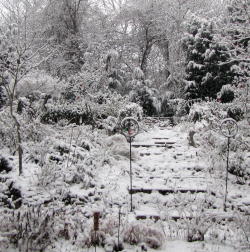
Under the spreading Daphne odora, the Cyclamen hederifolium stands*. (With apologies to Henry Wadsworth Longfellow, the original poem can be seen at the end of this post.)

The Fairegarden is awash in purple Perilla frutescens, a story about it can be seen by clicking here. We have been lax in pulling it out of the gravel paths because it is pretty and some is always allowed to grow on to flower and set seed to keep it going from year to year. This fall, it is covered in honeybees. Exotics on exotics. It seems right.

Both exotics and natives are welcome here. Some of the latter were pulled up as weeds in the earliest stages of this garden, the thinking being that if I didn’t plant it, it must be a weed. Thank goodness good sense has since prevailed and the garden now welcomes those formerly known as weeds. White Joe Pye, Eupatorium perfoliatum, maybe, is joined by the dark purple ironweed, Vernonia gigantea in the Black Garden. All it needs is some yellow goldenrod for a perfect wildflower bouquet. These tall flowers are cut back by half in May to keep them a bit shorter in stature, a how to post about that can be seen by clicking here. The better to see you, my dears.

It is in late summer that flocks of beautiful Eastern Goldfinches descend upon the tall green coneflowers. These birds are somewhat shy and the intrepid photographer has had trouble sneaking up to capture them in pixels. Gotcha!

Standing statue still, clicking as quickly but quietly as possible, the feeding is recorded for blog posterity.

Rudbeckia lanciniata has many blooms to offer hungry birds this year. These goldfinches are the exact same color as the petals, making it difficult to spot them. It is the movement that alerts us to their whereabouts.

Nearby, there has been soil sifting done under the brushpiles that are maintained for wildlife habitat. Every five years or so, the woody stems and branches along with things too weedy for the compost bin have biodegraded enough to become the chocolate cake soil gardeners adore. This will be put to good use, rest assured.

Our old camera is slowly dying, the Canon Powershot A 720IS. It has a very good macro feature that is weakening over the course of thousands of shots being taken. It is put to use to show the face of Cuphea lanceolata ‘Purple Passion’, an annual that seeds about every year. This year seedlings were dug and planted in the raised box where the Dahlias live.

Several varieties of Cuphea ssp. were added to this bed, the better to offer supping opportunities to the hummingbirds who love the trumpet shaped blooms. Orange Cuphea ignea was grown over the winter as cuttings in the greenhouse/sunroom and planted outside in several places this spring. That has proven to be a raging success and will continue for 2014.

I love seeing those containers planted with succulents on warm climate sites, but most of those gorgeous littles are not hardy here in my USDA Zone 7a garden. Here is a succulent that is quite winter tolerant, though, Orostachys iwarenge. (This plant has a very offensive common name that will not be mentioned here.) The centers rise up in late summer and will die, but there are rosette babies all around each of them to live on well and prosper. These are planted in a small round hypertufa planter. Directions to make hypertufa can be found by clicking here.

The passion flower vine, Passiflora incarnata, post here, is setting fruit and that seems to have slowed down flower production. I could snip these lime lookalikes off, but kind of like them hanging there on the old wagon wheel rim, along with the metal bed springs. We have yet to see the Gulf fritillary butterflies whose larvae will only feed on the passion vine, but hope springs eternal that there will be some soon.

There are butterflies flitting about now, including many of the small ones. It is believe this is a pearl crescent resting on a fuzzy lambs ear leaf, Stachys byzantina. It looks pretty good to me.
Frances
* The Village Blacksmith
UNDER a spreading chestnut tree
The village smithy stands;
The smith, a mighty man is he,
With large and sinewy hands;
And the muscles of his brawny arms
Are strong as iron bands.
His hair is crisp, and black, and long,
His face is like the tan;
His brow is wet with honest sweat,
He earns whate’er he can,
And looks the whole world in the face,
For he owes not any man.
Week in, week out, from morn till night,
You can hear his bellows blow;
You can hear him swing his heavy sledge
With measured beat and slow,
Like a sexton ringing the village bell,
When the evening sun is low.
And children coming home from school
Look in at the open door;
They love to see the flaming forge,
And hear the bellows roar,
And watch the burning sparks that fly
Like chaff from a threshing-floor.
He goes on Sunday to the church,
And sits among his boys;
He hears the parson pray and preach,
He hears his daughter’s voice,
Singing in the village choir,
And it makes his heart rejoice.
It sounds to him like her mother’s voice,
Singing in Paradise!
He needs must think of her once more,
How in the grave she lies;
And with his hard, rough hand he wipes
A tear out of his eyes.
Toiling,—rejoicing,—sorrowing,
Onward through life he goes;
Each morning sees some task begin,
Each evening sees it close;
Something attempted, something done,
Has earned a night’s repose.
Thanks, thanks to thee, my worthy friend,
For the lesson thou hast taught!
Thus at the flaming forge of life
Our fortunes must be wrought;
Thus on its sounding anvil shaped
Each burning deed and thought!
By Henry Wadsworth Longfellow, 1807–1882
(I have to admit to learning the beginning of this poem in a Bugs Bunny cartoon as a child. Onward.)









I feel as I have walked through your September garden with you Frances, and it was lovely! I have grown passiflora caerulea before, and it was so lovely that first year. After that, the foliage tried to take over my garden, but stopped producing those fabulous flowers. I tore it out, but you know how that goes. It keeps popping up! I left a chunk of it, but don’t tell hubby, he wants it gone! Then I recently encountered passiflora incarnata for the first time, and fell in love with the fragrance. Maybe there will be a place for it here in Robin’s nest.
Funny how what goes around comes around.
Re the Gulf frits, I never thought I would say this because I plant on purpose for butterflies and their larvae; but I’ve had 3 varieties of passion vines that have all bitten the dust, thanks to the fritillaries. Each year, twice a year, I am inundated with the little munching critters that decimate the vines in short order. After about 3 years of being eaten to the ground, the vines give up. Never even get to see a bloom. I love butterflys and it is obvious that the frits are happy but I do wish, just once, they would let up and allow a passion vine vigorous enough to sport a bloom !
The passion vines are quite sneaky here … last year they ran under the granite path and came up in another bed! I’m seeing fritillaries on them now so I am letting the largest vines run rampant. I may be sorry!
Frances, I haven’t seen any Gulf fritillary cats either….but as you said, hope does spring eternal. You must be ever so quiet and still to capture the Goldfinches likenesses so well. They never stay near when I am out and about. I do see lots of evidence that they have been nibbling on the coneflowers. Love the Perilla and I let some stay in the garden, too, the honeybees love its nectar and I appreciate the great color. xoxoxogail
The Goldfinches may be shy but they certainly look happy in your near-fall garden. It looks beautiful. I was surprised to see a Cyclamen in bloom now but I expect that’s just another indication of the vast differences between our climates.
I am sorry to hear your camera is dying. I need to get me some ironweed. I am surprised I don’t see it growing wild around here.
I have seen exactly 1 Gulf fritillary this year. Usually I see them everywhere in August. The maypop has always been eaten down by their caterpillars, but not this year. This has really worried me.
Thanks for this glimpse into your fall garden, Frances–it’s a different look than spring, but still so beautiful! I have been eyeing my purple coneflowers, debating whether to cut them back because they look so bad, but then the goldfinches come and I change my mind. It’s not easy capturing these shy creatures in pixels–great job!
Bugs Bunny cartoons actually could be educational:)
Frances,
So sad about the camera – I also find that old batteries can cause similar focus problems. Might be worth a try. Although, if there’s a new camera in your future – ignore this advice. Well done with the finches – such pretty little birds – and so quick. We’ve got a pair that come for a bath every evening – never close enough or fast enough to catch them.
B.
The Orostachys looks cool, that’s a new one for me and I’m going to have to keep my eyes open for it. I would have never suspected it was hardy. Thanks!
No passion vines in Massachusetts, but I have had lots of pearl Crescent butterflies this year. Your September garden looks great. Right now mine is just shouting – Get out here and do something!
Thank you for the tour of your September garden. I loved the visit and enjoyed the photography of the beautiful Goldfinches and the poem at the end…lovely!